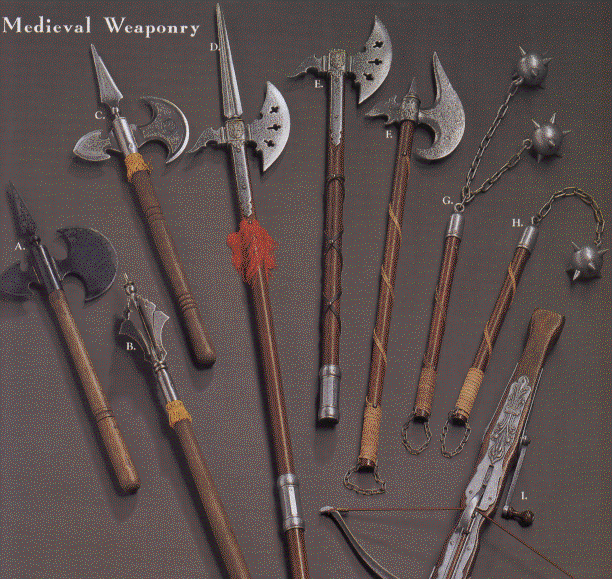Medieval Weapons used by the KnightsThe Medieval weapons which were used by the Knights included the following:
- Weapons - The Medieval Swords - The different types of Medieval swords ranged from the smallest Broadsword measuring from 30 inches to the Greatswords which measured up to 72 inches
- Weapons - The Broadsword
- The Falchion
- Weapons - The Bastardsword
- The Cutting sword
- Weapons - The Greatsword
- Weapons - The Battle Axe - A variety single and double-handed axe were in use throughout the Medieval period
- Weapons - The Mace - The Medieval mace was an armor-fighting weapon. The Mace developed from a steel ball on a wooden handle, to an elaborately spiked steel war club
- Weapons - The Dagger including the Basilard, a two-edged, long bladed dagger of the late Middle Ages
- Weapons - The Medieval Lance - A long, strong, spear-like weapon. Designed for use on horseback
The Medieval Knights attended the equivalent of a 'Knight School' serving seven years as a Page and a further seven years as a Squire in which he acquired the necessary strength and skills in the weapons of a Medieval Knight. These weapons were difficult to master and required continuous practise and training.
Medieval Weapons used by the Foot soldiers and ArchersThe range Weapons used in the Middle Ages by the foot soldiers and archers in the Middle Ages was considerable:
- Arbalest - This is the correct term for a Medieval Crossbow
- Axe - Single and double-handed battle axes
- Basilard - A two-edged, long bladed dagger
- Bill - A polearm with a wide cutting blade occasionally with spikes and hooks
- Billhook - Capable of killing Knights and their horses
- Medieval Bow and Arrow - the most common of all weapons
- Caltrop: Sharp spikes on 12 - 18 feet poles used, in formation, to maim a horse
- Crossbow - The crossbow range was 350 – 400 yards but could only be shot at a rate of 2 bolts per minute
- Dagger - A short pointed knife coonly used as weapons
- Flail - A jointed weapon consisting of a spiked or knobbed steel head joined by a chain to a short wood handle
- Glaive - A broad-bladed, single-edged polearm similar to a long butchers knife on a 6 foot pole
- Hache - An axe shaped cutting blade on one side and a small hammer head on the other on a 6 foot pole
- Halberd - A broad, short axe blade on a 6 foot pole with a spear point at the top with a back spike
- Hammer - Side-arm for combating armor pointed head
- Longbow - The Longbow could pierce armour at ranges of more than 250 yards - a longbowman could release between 10 - 12 arrows per minute
- Mace - The Medieval mace was an armor-fighting weapon. The Mace developed from a steel ball on a wooden handle, to an elaborately spiked steel war club
- Pike - A long spear measuring 18 feet
- Poleaxe - Polearm - Polehammer - Bec de Corbin - Bec de Faucon - A group of pole-mounted weapons. Were all variations of poles measuring 6 feet long with different 'heads' - spikes, hammers, axe etc
- Quarterstaff - A long, thick pole measuring between 6 - 9 feet
- Spear - Used for thrusting
- Warhammer - A hammer head on one side and a spike on the other
The weapons of the Middle Ages listed above were usually provided by a lord or noble. However many peasants were also called to the battlefield who were just armed with tools that were used when working on the land.
Medieval Weapons - Siege Warfare and Siege Weapons!The Medieval era saw the construction of hundreds of castles. A totally new form of warfare and weapons were introduced to England with the castles - Medieval Siege Warfare. Siege warfare tactics and weapons varied according to the role of Castle Defender or Castle Attacker. Siege weapons were made to order! The most famous Medieval Siege Weapons were the Ballista, Mangonel, Battering ram and the awesome Trebuchet. Siege warfare was extremely expensive! Any siege had to be carefully planned. Engineers identified the weakest parts of the Castle. A workforce including carpenters and blacksmiths were sent to the site. The surrounding area was checked out for materials and supplies. Armed men were expected to help prepare for the siege! The whole area outside the castle became a noisy hive of activity. The siege weapons would be built! During this siege preparation time the attackers would seek terms of surrender. Failure to 'Come to Terms' resulted in siege warfare and the use of the following siege weapons:
- Weapons - Battering Ram - The Battering Ram and the Bore were used to literally 'batter' down, pound, punch and shake and drill into castle gates, doors and walls
- Weapons - Ballista - The Ballista was similar to a Giant Crossbow and worked by using tension.
- Weapons - Mangonel - Missiles were launched from a bowl-shaped bucket at the end of the one giant arm of the Mangonel
- Weapons - Trebuchet - The massive Trebuchet consisted of a lever and a sling and was capable of hurling stones weighing 200 pounds with a range of up to about 300 yards
Medieval WeaponsThe facts and information about Weapons used during the period of the Middle Ages provide an overview of these weapons of Mass Medieval Destruction. For detailed facts and information click one of the following links. A glance at these pages will transport you into the terrifying world of Medieval weapons!

No comments:
Post a Comment